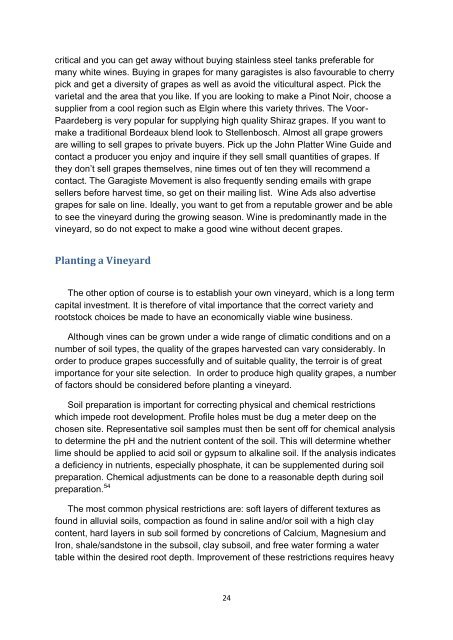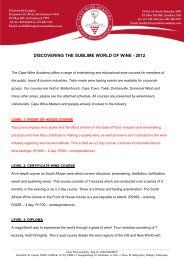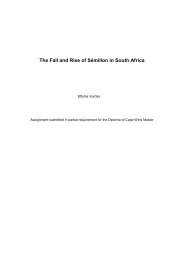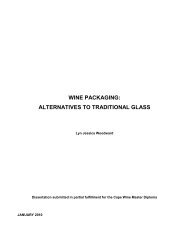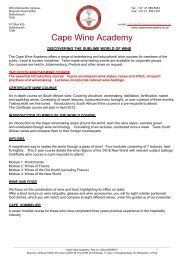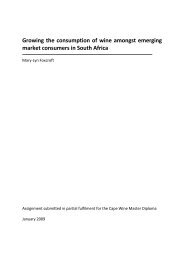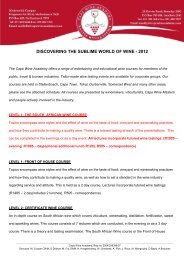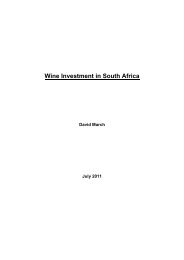Garage Winemaking in South Africa Less is More - Cape Wine ...
Garage Winemaking in South Africa Less is More - Cape Wine ...
Garage Winemaking in South Africa Less is More - Cape Wine ...
You also want an ePaper? Increase the reach of your titles
YUMPU automatically turns print PDFs into web optimized ePapers that Google loves.
critical and you can get away without buy<strong>in</strong>g sta<strong>in</strong>less steel tanks preferable for<br />
many white w<strong>in</strong>es. Buy<strong>in</strong>g <strong>in</strong> grapes for many garag<strong>is</strong>tes <strong>is</strong> also favourable to cherry<br />
pick and get a diversity of grapes as well as avoid the viticultural aspect. Pick the<br />
varietal and the area that you like. If you are look<strong>in</strong>g to make a P<strong>in</strong>ot Noir, choose a<br />
supplier from a cool region such as Elg<strong>in</strong> where th<strong>is</strong> variety thrives. The Voor-<br />
Paardeberg <strong>is</strong> very popular for supply<strong>in</strong>g high quality Shiraz grapes. If you want to<br />
make a traditional Bordeaux blend look to Stellenbosch. Almost all grape growers<br />
are will<strong>in</strong>g to sell grapes to private buyers. Pick up the John Platter W<strong>in</strong>e Guide and<br />
contact a producer you enjoy and <strong>in</strong>quire if they sell small quantities of grapes. If<br />
they don‟t sell grapes themselves, n<strong>in</strong>e times out of ten they will recommend a<br />
contact. The Garag<strong>is</strong>te Movement <strong>is</strong> also frequently send<strong>in</strong>g emails with grape<br />
sellers before harvest time, so get on their mail<strong>in</strong>g l<strong>is</strong>t. W<strong>in</strong>e Ads also advert<strong>is</strong>e<br />
grapes for sale on l<strong>in</strong>e. Ideally, you want to get from a reputable grower and be able<br />
to see the v<strong>in</strong>eyard dur<strong>in</strong>g the grow<strong>in</strong>g season. W<strong>in</strong>e <strong>is</strong> predom<strong>in</strong>antly made <strong>in</strong> the<br />
v<strong>in</strong>eyard, so do not expect to make a good w<strong>in</strong>e without decent grapes.<br />
Plant<strong>in</strong>g a V<strong>in</strong>eyard<br />
The other option of course <strong>is</strong> to establ<strong>is</strong>h your own v<strong>in</strong>eyard, which <strong>is</strong> a long term<br />
capital <strong>in</strong>vestment. It <strong>is</strong> therefore of vital importance that the correct variety and<br />
rootstock choices be made to have an economically viable w<strong>in</strong>e bus<strong>in</strong>ess.<br />
Although v<strong>in</strong>es can be grown under a wide range of climatic conditions and on a<br />
number of soil types, the quality of the grapes harvested can vary considerably. In<br />
order to produce grapes successfully and of suitable quality, the terroir <strong>is</strong> of great<br />
importance for your site selection. In order to produce high quality grapes, a number<br />
of factors should be considered before plant<strong>in</strong>g a v<strong>in</strong>eyard.<br />
Soil preparation <strong>is</strong> important for correct<strong>in</strong>g physical and chemical restrictions<br />
which impede root development. Profile holes must be dug a meter deep on the<br />
chosen site. Representative soil samples must then be sent off for chemical analys<strong>is</strong><br />
to determ<strong>in</strong>e the pH and the nutrient content of the soil. Th<strong>is</strong> will determ<strong>in</strong>e whether<br />
lime should be applied to acid soil or gypsum to alkal<strong>in</strong>e soil. If the analys<strong>is</strong> <strong>in</strong>dicates<br />
a deficiency <strong>in</strong> nutrients, especially phosphate, it can be supplemented dur<strong>in</strong>g soil<br />
preparation. Chemical adjustments can be done to a reasonable depth dur<strong>in</strong>g soil<br />
preparation. 54<br />
The most common physical restrictions are: soft layers of different textures as<br />
found <strong>in</strong> alluvial soils, compaction as found <strong>in</strong> sal<strong>in</strong>e and/or soil with a high clay<br />
content, hard layers <strong>in</strong> sub soil formed by concretions of Calcium, Magnesium and<br />
Iron, shale/sandstone <strong>in</strong> the subsoil, clay subsoil, and free water form<strong>in</strong>g a water<br />
table with<strong>in</strong> the desired root depth. Improvement of these restrictions requires heavy<br />
24


